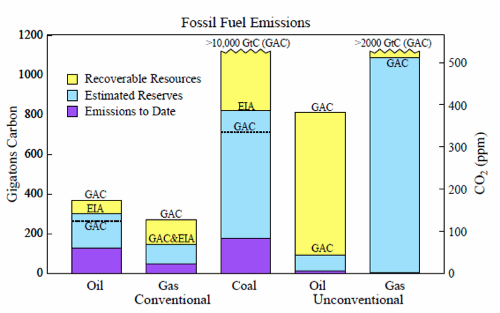James Hansen Slams Obama's Lack Of Climate Leadership And Our 'Immoral' Inaction
 The nation’s most famous climatologist, NASA’s James Hansen, has written a scathing NY Times op-ed, “Game Over for the Climate.” He also lays out an “apocalyptic” but science-based description of what happens if we keep doing nothing.
The nation’s most famous climatologist, NASA’s James Hansen, has written a scathing NY Times op-ed, “Game Over for the Climate.” He also lays out an “apocalyptic” but science-based description of what happens if we keep doing nothing.Hansen begins:
GLOBAL warming isn’t a prediction. It is happening.
That is why I was so troubled to read a recent interview with President Obama in Rolling Stone in which he said that Canada would exploit the oil in its vast tar sands reserves “regardless of what we do.”
If Canada proceeds, and we do nothing, it will be game over for the climate.
Canada’s tar sands, deposits of sand saturated with bitumen, contain twice the amount of carbon dioxide emitted by global oil use in our entire history. If we were to fully exploit this new oil source, and continue to burn our conventional oil, gas and coal supplies, concentrations of carbon dioxide in the atmosphere eventually would reach levels higher than in the Pliocene era, more than 2.5 million years ago, when sea level was at least 50 feet higher than it is now.
Hansen lays out why the scientific case for why exploiting the tar sands and unconventional fuels in general would be “game over” for modern civilization:
The global warming signal is now louder than the noise of random weather, as I predicted would happen by now in the journal Science in 1981. Extremely hot summers have increased noticeably. We can say with high confidence that the recent heat waves in Texas and Russia, and the one in Europe in 2003, which killed tens of thousands, were not natural events — they were caused by human-induced climate change.
We have known since the 1800s that carbon dioxide traps heat in the atmosphere. The right amount keeps the climate conducive to human life. But add too much, as we are doing now, and temperatures will inevitably rise too high. This is not the result of natural variability, as some argue. The earth is currently in the part of its long-term orbit cycle where temperatures would normally be cooling. But they are rising — and it’s because we are forcing them higher with fossil fuel emissions.
The concentration of carbon dioxide in the atmosphere has risen from 280 parts per million to 393 p.p.m. over the last 150 years. The tar sands contain enough carbon — 240 gigatons — to add 120 p.p.m. Tar shale, a close cousin of tar sands found mainly in the United States, contains at least an additional 300 gigatons of carbon. If we turn to these dirtiest of fuels, instead of finding ways to phase out our addiction to fossil fuels, there is no hope of keeping carbon concentrations below 500 p.p.m. — a level that would, as earth’s history shows, leave our children a climate system that is out of their control.
This is an op-ed, so Hansen can’t provide his underlying scientific analysis and charts. Here is the key chart:

CO2 emissions by fossil fuels [1 ppm CO2 ~ 2.12 GtC, where ppm is parts per million of CO2 in air and GtC is gigatons of carbon] via Hansen. Significantly exceeding 450 ppm risks several severe and irreversible warming impacts. [Estimated reserves and potentially recoverable resources are from EIA (2011) and GAC (2011).]
Hansen himself has been increasingly vocal on just what it would mean to stay anywhere near our current emissions path. This piece lays out the picture bluntly:
That level of heat-trapping gases would assure that the disintegration of the ice sheets would accelerate out of control. Sea levels would rise and destroy coastal cities. Global temperatures would become intolerable. Twenty to 50 percent of the planet’s species would be driven to extinction. Civilization would be at risk.
That is the long-term outlook. But near-term, things will be bad enough. Over the next several decades, the Western United States and the semi-arid region from North Dakota to Texas will develop semi-permanent drought, with rain, when it does come, occurring in extreme events with heavy flooding. Economic losses would be incalculable. More and more of the Midwest would be a dust bowl. California’s Central Valley could no longer be irrigated. Food prices would rise to unprecedented levels.
If this sounds apocalyptic, it is.
Again, this is all from the recent scientific literature.
Hansen is tough on Obama — and all of us:
This is why we need to reduce emissions dramatically. President Obama has the power not only to deny tar sands oil additional access to Gulf Coast refining, which Canada desires in part for export markets, but also to encourage economic incentives to leave tar sands and other dirty fuels in the ground….
We need to start reducing emissions significantly, not create new ways to increase them. We should impose a gradually rising carbon fee, collected from fossil fuel companies…. [T]he reduction in oil use resulting from the carbon price would be nearly six times as great as the oil supply from the proposed pipeline from Canada, rendering the pipeline superfluous, according to economic models driven by a slowly rising carbon price.
But instead of placing a rising fee on carbon emissions to make fossil fuels pay their true costs, leveling the energy playing field, the world’s governments are forcing the public to subsidize fossil fuels with hundreds of billions of dollars per year. This encourages a frantic stampede to extract every fossil fuel through mountaintop removal, longwall mining, hydraulic fracturing, tar sands and tar shale extraction, and deep ocean and Arctic drilling.
President Obama speaks of a “planet in peril,” but he does not provide the leadership needed to change the world’s course. Our leaders must speak candidly to the public — which yearns for open, honest discussion — explaining that our continued technological leadership and economic well-being demand a reasoned change of our energy course. History has shown that the American public can rise to the challenge, but leadership is essential.
The science of the situation is clear — it’s time for the politics to follow. This is a plan that can unify conservatives and liberals, environmentalists and business. Every major national science academy in the world has reported that global warming is real, caused mostly by humans, and requires urgent action. The cost of acting goes far higher the longer we wait — we can’t wait any longer to avoid the worst and be judged immoral by coming generations.
You can return to the main Market News page, or press the Back button on your browser.

